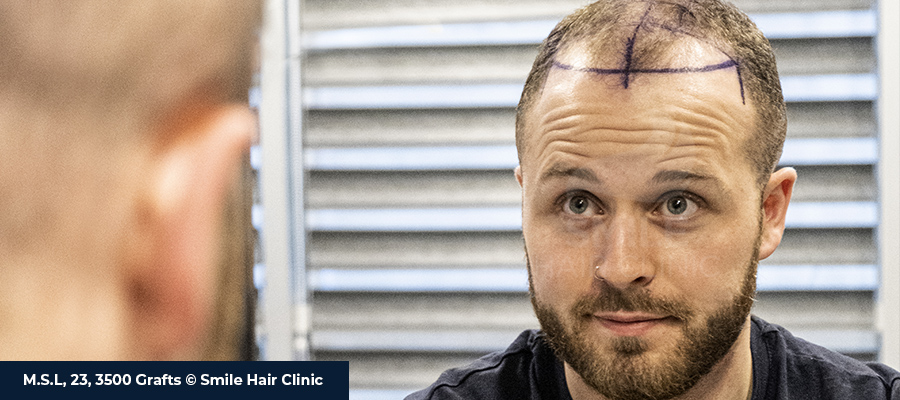Hair Loss in Men

Hair Loss in Men
Hair Loss in men, Most men have a hair loss problem that starts in their late 20s and increases in their 50s. Hair loss in men may be due to the frequency of hair wash, skin conditions, infections, malnutrition, and drugs used. Still, it is primarily genetic and is called as androgenetic alopecia.
The male hormone testosterone is responsible for genetic hair loss; this hormone interacts with the 5-alpha-reductase enzyme found in the hair bud (capillary bulb), and turns into dihydrotestosterone (DHT). DHT leads to thinning, dilution, and eventually loss of hair.
This type of hair loss is called “androgenetic alopecia,” which is “AGA.” Current medical understanding is that many genes play a role in the formation of AGA. To date, 8 suspicious areas on the X chromosome in male hair loss, including the part encoded by the androgen gene receptor, have been reported.
Recent studies have stated that surprisingly early-onset AGA and some other major diseases may have surprising genetic links with one another. Still, these links have not yet been fully proven. In addition, it has been vindicated that increases in Prostaglandin D2 levels are responsible for AGA-style hair loss.
WHAT IS MALE-TYPE HAIR LOSS?
AGA (Androgenetic Alopecia) is men’s most common cause of hair loss. It is colloquially called male pattern hair loss, usual baldness, and masculine hair loss.
This type of shedding occurs with the conversion of testosterone, the most dominant androgenic hormone, to dihydrotestosterone by the 5-alpha-reductase enzyme in our hair follicles and by the effective response of our hair follicles, starts on both sides of the head (bitemporal). Spills follow it in the mid-front line.
In this process, first of all, the hair becomes thinner and weak, it transforms from thick and solid roots to barely visible baby hair, and this thinning is called miniaturization. If it is not intervened through treatment in this period, permanent loss will occur.
Hair loss and baldness create intense stress on people, directly affecting the person’s social life negatively. Patients lose their self-confidence. Our doctors generally hear the sentence “My self-confidence has been restored” from their patients. Half of the men who have reached the age of 50 experience hair loss due to androgenetic alopecia.
The diagnosis of hair loss is made by simple tests applied during the examination by doctors. It is possible to stop or slow down and prevent these spills through the right treatment and practices.
TREATMENTS OF HAIR LOSS IN MEN
Finasteride
As we mentioned before, the biggest reason for hair loss in men is “androgenetic alopecia” = “AGA,” that is, genetic male pattern hair loss. Medicines containing finasteride prevent the formation of dihydrotestosterone (DHT) by inhibiting the activity of the 5-alpha-reductase enzyme.
In this way, the thinning of the hair and eventually spillage is prevented. Smile Hair Clinic recommends finasteride treatment to male patients who have had Sapphire Hair Transplantation and who experience hair loss. In the follow-ups made by our doctors, it has been observed that the finasteride treatment contributed significantly to the hair health of our patients.
Unfortunately, there are unrealistic myths about the side effects of this medicine on the internet. In scientific research, it has been proven that the use of this medicine has no scientific connection with the related side effects mentioned on that sites. It should not be forgotten that Finasteride treatment is a treatment approved by FDA.
FUE HAIR TRANSPLANTATION
Sapphire hair transplantation is the most effective treatment method for people with hair loss. FUE hair transplant operations performed by experienced surgeons in this field enable people to regain their previous appearance and perhaps go back decades.
Although sapphire hair transplantation is a simple procedure in many mediums, it is a complicated surgical procedure that requires knowledge and experience. Patient-specific planning should be made and carried out carefully in this process.
In our blog, you can find detailed information on what to pay attention to while choosing a clinic for FUE hair transplantation and sapphire hair transplant operations.
NORWOOD CLASSIFICATION IN MALE HAIR LOSS
Norwood Classification is used for male hair loss. The table below shows the average number of grafts needed by the person according to Norwood classification with its grades.
In the Norwood classification, FUE hair transplantation should be planned in two sessions for people with type 5-6-7 grade of hair loss, and severe hair loss cannot be covered in a single session.
People with such a high grade of hair loss and who research sapphire hair transplantation should not believe those who say they can cover it in one session by promising them vain hopes. Some clinics make unrealistic predictions of grafts for patients to prefer.
Choosing an experienced clinic that will tell them all possible results will prevent the great disappointments that the person will experience at the end of the waiting period.
 Whatsapp
Whatsapp
